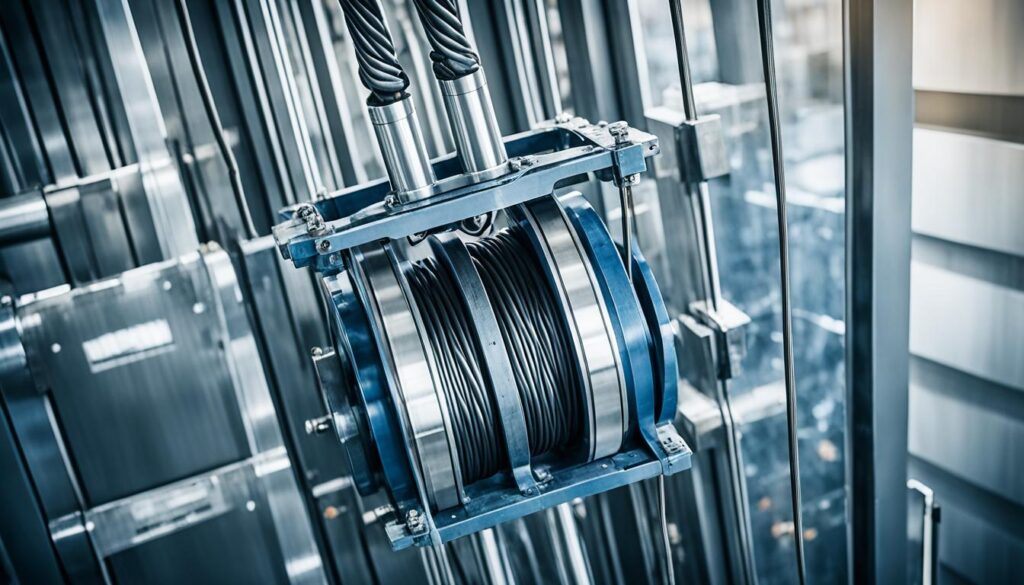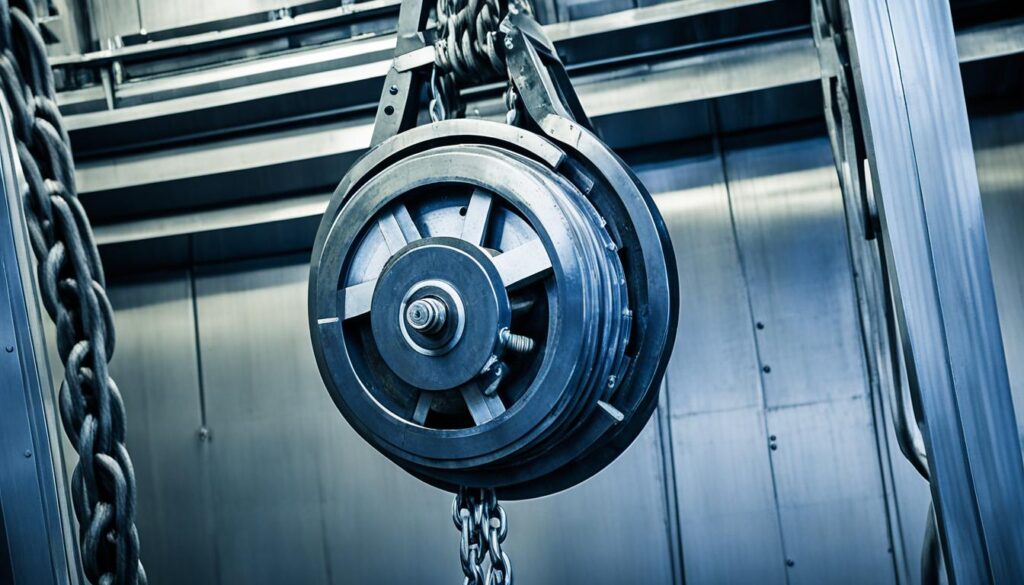In the intricate world of elevator systems, the counterweight plays a crucial role in ensuring smooth and efficient lift operations. As the backbone of these mechanical marvels, the elevator counterweight exerts an opposing force to the lifted load, making it easier for the motor to raise and lower the car. This delicate balance is a crucial factor in the design and engineering of elevators, as it directly impacts the overall performance, energy consumption, and safety of the system.
The counterweight’s primary function is to counteract the weight of the elevator car and its contents, reducing the strain on the motor and optimizing the system’s energy usage. By carefully calibrating the counterweight’s mass to match the car’s weight, we can achieve a near-perfect equilibrium, minimizing the force required from the motor to move the car up and down. This not only enhances the smoothness of the ride but also extends the lifespan of the motor and other critical components, leading to reduced maintenance costs and increased reliability.
Key Takeaways
- Elevator counterweights are essential for maintaining a balanced and efficient elevator system.
- They help reduce the strain on the motor, leading to energy savings and smoother operations.
- Counterweights are a crucial factor in meeting elevator performance criteria, such as acceleration and deceleration.
- Proper counterweight design and maintenance ensure the longevity of elevator components and enhance overall safety.
- Understanding the role of counterweights is crucial for engineers and technicians in the elevator industry.
The Crucial Role of Elevator Counterweights
In the world of elevator engineering, the humble elevator counterweight plays a vital role in ensuring smooth and efficient lift operations. These ingenious mechanisms, designed with precision, not only balance the weight of the elevator car but also contribute to enhanced safety features and extended component lifespan.
Balancing Efficiency and Reducing Motor Strain
The elevator counterweight is responsible for offsetting the weight of the car, which in turn reduces the cable tension and the strain on the elevator motors. This balance of forces results in increased energy efficiency, as the motors consume less energy during the lifting process. By minimizing the workload on the motors, the elevator counterweight helps extend the component lifespan and reduces the frequency of elevator maintenance required over time.
Enhancing Safety and Extending Component Lifespan
Beyond its role in weight balance, the elevator counterweight also plays a crucial part in enhancing the overall safety of the system. By reducing the cable tension, the counterweight lessens the strain on the cables, which are integral to the elevator safety mechanism. This redundancy of multiple metal strands twisted together in the cables ensures that even if one cable fails, the others continue to support the car, preventing catastrophic accidents.
Additionally, the elevator counterweight contributes to the design engineering of the system, with careful considerations given to its shaft and cable system to ensure stable and safe operation. By calculating the load increase distance based on the mass of the counterweight and its distance from the tipping point, engineers can optimize the elevator’s performance and extend the lifespan of its critical components.

“Counterweights in elevator systems provide not only balancing efficiency but also enhanced safety features and energy savings.”
Elevator Counterweight: Types and Design Considerations
When it comes to elevator systems, the counterweight plays a crucial role in ensuring smooth and efficient operation. Elevator counterweights come in various types, each designed to serve a specific purpose and address unique challenges. Understanding the different types of counterweights and their design considerations is essential for engineers and technicians responsible for elevator maintenance and installation.
Traditional concrete counterweights have long been the go-to choice for many elevator systems. These heavy-duty counterweights provide the necessary weight balance to offset the elevator car’s weight, reducing the strain on the elevator motor and cables. However, as construction techniques have evolved, alternative counterweight options have emerged to address space constraints and weight considerations.
- Cast iron counterweights offer a more compact solution, allowing for greater flexibility in elevator shaft design and installation.
- Compound counterweights, made of a combination of steel and concrete, provide a unique balance of strength and weight reduction, making them a popular choice in modern elevator design engineering.
Regardless of the counterweight type, the design considerations for a stable elevator counterweight system are crucial. Calculating the load increase distance based on the mass of the counterweight and its distance from the tipping point is essential to ensure safe and smooth elevator operation. This delicate balance helps maintain the proper elevator cable tension and elevator weight balance, enhancing the elevator safety mechanism and extending the lifespan of critical components.
“Elevator counterweights are the unsung heroes of the vertical transportation industry, silently working behind the scenes to keep our elevators running smoothly and safely.”
As elevator design and engineering continue to evolve, the importance of elevator shaft counterweight systems and counterweight cable system design will remain paramount. Staying informed about the latest advancements in elevator maintenance counterweight technologies is crucial for industry professionals to ensure the safety and reliability of elevator systems.
Conclusion
The elevator counterweight is a crucial component that ensures the efficient and safe operation of elevators. These counterweights play a vital role in balancing the system, reducing the strain on the motor, and enhancing overall safety. By understanding the importance of elevator weight balance and the various design considerations that go into elevator counterweight systems, businesses can ensure their elevators operate smoothly and reliably.
The elevator cable tension and safety mechanisms are greatly improved by the presence of a properly designed elevator shaft counterweight. This not only enhances the overall elevator safety but also extends the lifespan of the various components, reducing the need for frequent maintenance and repairs. Investing in high-quality counterweight cable systems is crucial for maintaining the efficiency and longevity of an elevator system.
In conclusion, the elevator counterweight is a vital element of elevator design and engineering, and its importance cannot be overstated. By prioritizing the understanding and proper implementation of elevator counterweight systems, businesses can ensure their elevators operate at peak performance, providing a safe and reliable experience for all users.
FAQ
What is the purpose of elevator counterweights?
Elevator counterweights play a crucial role in ensuring the efficiency of elevator systems by exerting an opposite force to the lifted load, making it easier for the motor to raise and lower the car. This balancing effect reduces the amount of force required from the motor, leading to energy savings and smoother operations.
How do elevator counterweights enhance safety?
Counterweights in elevator systems enhance safety by reducing cable strain and providing additional energy sources for stopping mechanisms. The redundancy of multiple metal strands twisted together in the cables ensures that even if one cable fails, the others continue to support the car, preventing catastrophic accidents.
What are the different types of elevator counterweights?
Elevator counterweights come in different types, such as traditional concrete counterweights, cast iron counterweights, and compound counterweights (made of both steel and concrete). The choice between these types depends on factors such as space constraints, weight considerations, and the desired strength-to-weight ratio.
What design considerations are crucial for stable elevator counterweight systems?
Design considerations for stable elevator counterweight systems include calculating the load increase distance based on the mass of the counterweight and its distance from the tipping point to ensure safe and smooth operation. This is crucial to prevent over-balancing and ensure the counterweight system functions as intended.


